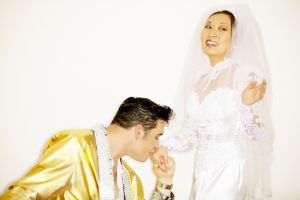 Maria Yoon is a Korean-born visual and performance artist who recently got married for the fiftieth time in Times Square in New York City. The artist has made a documentary about her experience. Yoon has become known as "the voice of the unmarried Asian-American woman," even though she acted the part of the bride that married 50 times in wedding ceremonies across the United States over the course of nine years. The film documents the ambivalence of a first generation Asian-American woman over 30 who had not yet married and was not particularly inclined to marry, but who felt great and increasing pressure from her parents to do so. It also takes a look at what the artist says are the vast and diverse subcultures that make up the United States and how they address marriage.
Maria Yoon is a Korean-born visual and performance artist who recently got married for the fiftieth time in Times Square in New York City. The artist has made a documentary about her experience. Yoon has become known as "the voice of the unmarried Asian-American woman," even though she acted the part of the bride that married 50 times in wedding ceremonies across the United States over the course of nine years. The film documents the ambivalence of a first generation Asian-American woman over 30 who had not yet married and was not particularly inclined to marry, but who felt great and increasing pressure from her parents to do so. It also takes a look at what the artist says are the vast and diverse subcultures that make up the United States and how they address marriage.
First, a Dress
In what appears to be a bit of irony, it all starts with the dress. In truth, it probably was a seed that grew with dinner table arguments and blind date recommendations. There was a dress, however. Yoon's mother bought her a traditional Korean hanbok, presumably as an incentive. It is more than just a simple dress. The hanbok is a colorful and elaborate ceremonial costume consisting of a variety of layers and accessories. Yoon wore specific makeup with the hanbok as well. One of the more powerful elements of the documentary is the juxtaposition Yoon presents to her various bridegrooms. Even at a drive-thru chapel or beside a Diana Ross impersonator in Las Vegas, Yoon maintains a solemnity that lends gravitas to the occasion. In still pictures, no matter the surreal or even silly environment, the bride keeps her serious expression, eyes cast down.
Coast to Coast Nuptials
Yoon organized all the events, but says she was moved specifically and in general by the generosity and cooperation of people across the country. Every ceremony had a photographer, an officiant, and guests that sometimes numbered up to 300. She praises the participating communities for their kindness, and says the one thing every place had in common were people who wanted to feed her. In Hawaii, Yoon got married on the beach to a man in traditional Hawaiian garb. In Wyoming, she got hitched while sitting atop a horse. Humans were not her only bridegrooms a cow and a T-shirt made the list as well. The work as a whole may ask the question, what does it mean to get married? Yoon has said that she was amazed by the difference in attitude and customs relating to marriage from state to state. Her own attitudes changed somewhat on the journey. Whereas at the start she felt more pull toward her work and her career, at the end she says she better appreciated the concept of balance. Her parents' behavior has shifted a little, too. Her mother is proud of the work she has done. Although Yoon knows her father would still like to see her marry, they are better able to discuss the subject together.
The State of the Union
In 2010, married couples in the United States made up less than half of all American households. While this number seems to point to a decline in the desire to be married, Yoon agrees with the medical wisdom that married people may live longer, healthier and more prosperous lives than their unmarried friends. The experiment may have resulted in a broadened understanding of what it is her parents want for her, including companionship and security. It does not necessarily mean that Yoon is out actively spouse-hunting, but neither does it mean that marriage is off the table. The act of getting married, even 50 times, even at a drive-thru chapel, may be nothing to take lightly. It is a ceremony that seems to be steeped in history and ritual and meaning across cultural and physical borders.
Add Your Comment